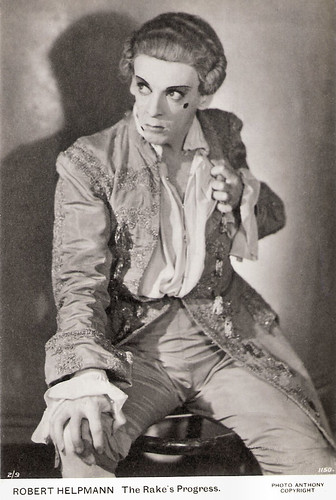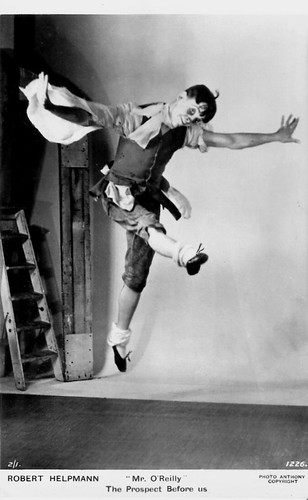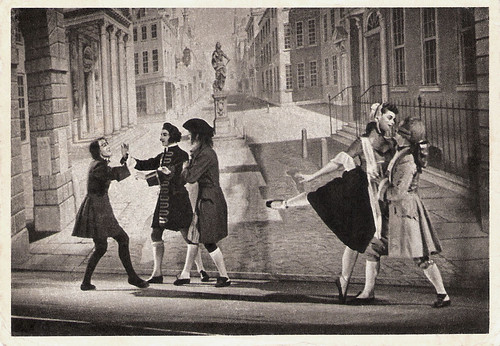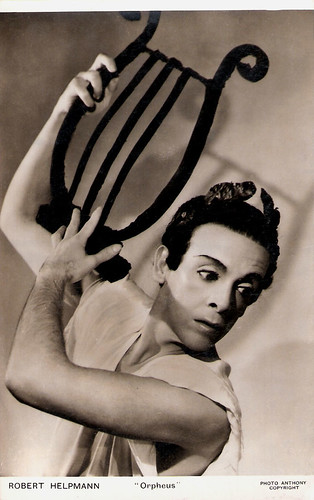
British postcard. Photo: Gordon Anthony. Publicity still for the Sadler's Wells ballet production The Rake's Progress.

British postcard, no. 1226. Photo: Gordon Anthony. Publicity still for the ballet production The Prospect Before Us with Robert Helpmann as Mr. O' Reilly. Part of a collection of portraits of Robert Helpmann on stage.
The Red Shoes
Robert Helpmann was born Robert Murray Helpman (spelt with one n) in Mount Gambier, South Australia, in 1909. His parents were James Murray Helpman a Victorian-born stock and station agent, and his wife Mary, née Gardiner. He had a younger sister Sheila Mary Helpman, and a younger brother Max, or Maxwell Gardiner Helpman, who both later became actors.
‘Bobby’ was dark-haired, pale, and had large dark eyes. He was educated at Prince Alfred College, Adelaide, but left school at 14. From childhood, Helpmann had a strong desire to be a dancer. This was an unusual ambition in provincial Australia of the 1920s. His mother—herself stage - struck from an early age — was to be a driving force in his career.
Helpmann was taught ballet by Nora Stewart. According to Wikipedia, she taught him the moves and dances of a girl because she had no prior experience teaching boys. He first danced solo at the Theatre Royal, Adelaide in The Ugly Duckling in 1922. In 1926 he joined as a student the touring dance company of the Russian ballerina Anna Pavlova. The introduction came via his father, who was on a business trip to Melbourne, where he met Pavlova who was dancing there.
His professional career began in 1927 when he joined the British J. C. Williamson Ltd as the principal dancer in Frasquita for its Australasian tour. In Britain, he went on to become the principal dancer at the Sadler’s Wells ballet (now the Royal Ballet) from 1933 to 1950. During the 1930s some of the ballets in which he danced were televised by the BBC, including Job (1936) in the important role of Satan.
In 1937 he created an enduring partnership with Margot Fonteyn. They were a popular pair, particularly during World War II, and danced a large classical repertoire.
In the 1940s, as he passed his peak as a dancer, Helpmann turned to production and to acting. He produced his own ballets — Comus (1942), Hamlet (1942), The Birds (1942), Miracle in the Gorbals (1944), Caravan (1946), and Adam Zero (1946).
The highpoint of Helpmann's career as a dancer was the Sadler's Wells Ballet tour of the United States in 1949, with Fonteyn and Helpmann dancing the leading roles in The Sleeping Beauty. The production caused a sensation, which made the names of both the Royal Ballet and its two principals; public and press alike referred to them affectionately as Bobby and Margot. Although Helpmann was past his best as a dancer, the tour opened doors for him in the United States as an actor and director.
In 1942 he played the Dutch Quisling in the Powell/Pressburger film One of Our Aircraft Is Missing (Michael Powell, Emeric Pressburger, 1942). The film follows the fortunes of six British airmen shot down over Holland as they try to make their way to the coast and back to England.
He then played the Bishop of Ely in the Shakespeare adaptation Henry V (Laurence Olivier, 1944).
Helpmann then played the principal dancer role of Ivan Boleslawsky in the first British ballet film The Red Shoes (Michael Powell, Emeric Pressburger, 1948). For this very successful film he was also the choreographer. The team followed it up with another ballet film, The Tales of Hoffmann (Michael Powell, Emeric Pressburger, 1951).
He later played the Chinese Prince Tuan in 55 Days at Peking (Nicholas Ray, Guy Green, 1963). On stage, he performed roles from Shakespeare at the Canadian Stratford Shakespeare Festival and at the Old Vic theatre company in London, playing the title role in Hamlet two years after having danced the same part. In 1963, he directed the world tour of Margot Fonteyn.

British postcard, no. 163. Photo: Tunbridge - Sedgwick. Publicity still for the ballet production Hamlet with Margot Fonteyn and Robert Helpmann as Ophelia and Hamlet, c. 1942.

British postcard by Ward Gallery, no. 601. Photo: Merlyn Severn. Publicity still for the ballet production The Rake's Progress with Robert Helpmann and Julia Farron.
Gay and Flamboyant
In 1965 Robert Helpmann returned to Australia to become co-director of the Australian Ballet, bringing with him an international theatrical reputation and connections with dancers, choreographers and companies across the world. He created a series of important choreographic works and led the company on several international tours.
Since he was gay and flamboyant, his arrival in very conservative Australia caused some consternation, according to Wikipedia. Australians were proud of his international fame, but not sure what to make of him personally.
Helpmann joined Dame Peggy van Praagh at the helm of the fledgling company, as her co-director until 1974 and sole director until 1976. He choreographed ballets including Yugen (1965), Elektra (1967, revised from the original version created for the Royal Ballet in 1963), Sun Music (1968), Perisynthyon (1974) and produced and directed The Merry Widow (1975).
He continued to appear in films. One of his most recognized screen roles is the sinister Child Catcher in the family classic Chitty Chitty Bang Bang (Ken Hughes, 1968).
Another family film he starred in was Alice's Adventures in Wonderland (William Sterling, 1972), in which he portrayed the Mad Hatter opposite the young Fiona Fullerton as Alice.
And for The Australian Ballet he co-directed with Rudolf Nureyev the ballet-film Don Quixote (1973), in which he also played the title role.
In 1938, Helpmann had met a young Oxford undergraduate while fulfilling an invitation to dance at the university. He was immediately drawn to the handsome and intelligent Michael Benthall, and the pair formed a relationship that was to last for 36 years until Benthall's death in 1974. The couple lived and often worked together quite openly for the time.
Although devastated by the loss of his longtime companion and collaborator, ‘Sir Bobby’ continued to act, direct and produce. Among his later films is the Australian horror film Patrick (Richard Franklin, 1978), with Susan Penhaligon. He made various guest appearances in ballets in Australia and abroad.
At 77, Robert Helpmann died in Sydney in 1986. In 1964 he had been appointed a Commander of the Order of the British Empire (CBE). In 1965 he was named ‘Australian of the Year’ and in 1968 he was appointed a Knight Bachelor (KBE).

British postcard. Photo: Gordon Anthony. Publicity still for the Sadler's Wells ballet production Orpheus and Eurydice (1941) with Robert Helpmann as Orpheus.

British postcard. Photo: Gordon Anthony. Publicity still for the Sadler's Wells ballet production Comus (1942) with Robert Helpmann in the title role.
Sources: Christopher Sexton (Australian Dictionary of Biography), Steve Crook (IMDb), Encyclopaedia Britannica, Wikipedia and IMDb.
No comments:
Post a Comment